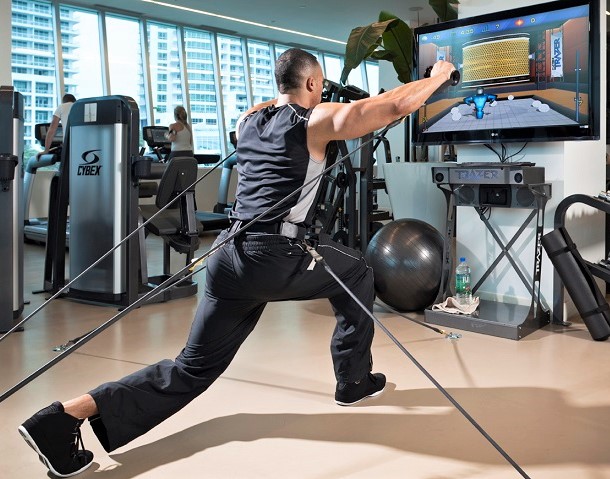Trazer2 / Trazer
Exergaming is not new. The term originated around two decades ago, and articles like this one have been hyping it as a next big thing for nearly that long. We make no such predictions. The combination of exercise and gaming may not be coming to your gym or home anytime soon. But it’s clearly here to stay, and it represents an option for bringing another level of competition, whether against others or your previous bests, to your workouts. The Barbell explores the current state of exergaming and the potential benefits and downsides of gamifying your training.
WHAT IS EXERGAMING?
Exergaming is the combination of exercise and gaming technology with a point system that rewards you for reaching certain goals, whether alone or with others. It started with the arcade game Dance Dance Revolution in 1999 and went home with the Nintendo’s Wii Fit, introduced in 2007. And for a while it seemed to be a low-impact, low-intensity way of getting couch potatoes off the couch, but not something for regular gym-goers.
However, another strain of higher-intensity exergaming has grown progressively more popular. Some such exergames involve virtual reality. The global VR fitness game market was valued at $111 million in 2022, and it’s projected to grow at a compound annual rate of 40% from 2023 to 2029. Other exergames can be performed with an app, such as the interactive cycling experience, Zwift, or a console, such as Ring Fit on Nintendo Switch. The best known exercise equipment with a gaming component is Peloton. Exergaming is currently focused more on cardio and reflexive movements than resistance training, but there have been innovations with resistance machines. And more are sure to come.

BENEFITS OF EXERGAMING
IT’S FUN
A 2022 study looked at 55 people whose weekly exercise time fell short of the 150 minutes recommended by the U.S. Department of Health and Human Services. Some participants were assigned to group exercise classes, and some to exergaming. The class participants worked out harder than the exergamers, but the exergamers reported having more fun. “We forget sometimes that it’s really hard for inactive people to take that first step,” a co-author of the study said. “These games may be able to address that problem.”
INSTANT REWARD
It takes time to see gains from exercises, but an exergame can provide instant gratification via a point system. You know instantly that you’ve had a good workout, and you have a benchmark to beat to in your next workout.
GOOD PEER PRESSURE
In online fitness games, you compete against others either individually or as part of a team. Either way, your peers can hold you accountable and encourage you to improve, just as a good training partner in the gym would.
IMPROVE MENTAL HEALTH
Exergaming and mental health, particularly in older adults, is an exciting area of study. A survey of 10 different studies, concluded: “It was possible to observe a positive effect on mood; the reduction of apathy, anxiety and depression; self-esteem; and affection.”
ADAPTABLE AND SCALABLE
Exergames can be personalized for individuals and their needs and goals. For example, an overweight 60-year-old can compete against only others in their peer group. As they grow fitter, they can move into a fitter peer group of competitors.

DOWNSIDES OF EXERGAMING
TOO DATA DRIVEN
For some, a focus on points-per-workout can distract from the greater goals of improved fitness and/or an improved physique. Exergaming works best when you combine the exergame’s benchmarks with your own personal fitness goals and never lose sight of the latter.
TOO MUCH SCREEN TIME
For some, gazing at a video screen or VR goggles, alone, and exercising may merely add to the hours each day they’re spending in a virtual world. Exergaming is great as an adjunct to more traditional workouts or for those who otherwise wouldn’t exercise any other way (especially kids and the elderly), but if it becomes a virtual obsession it can be a problem.
















































